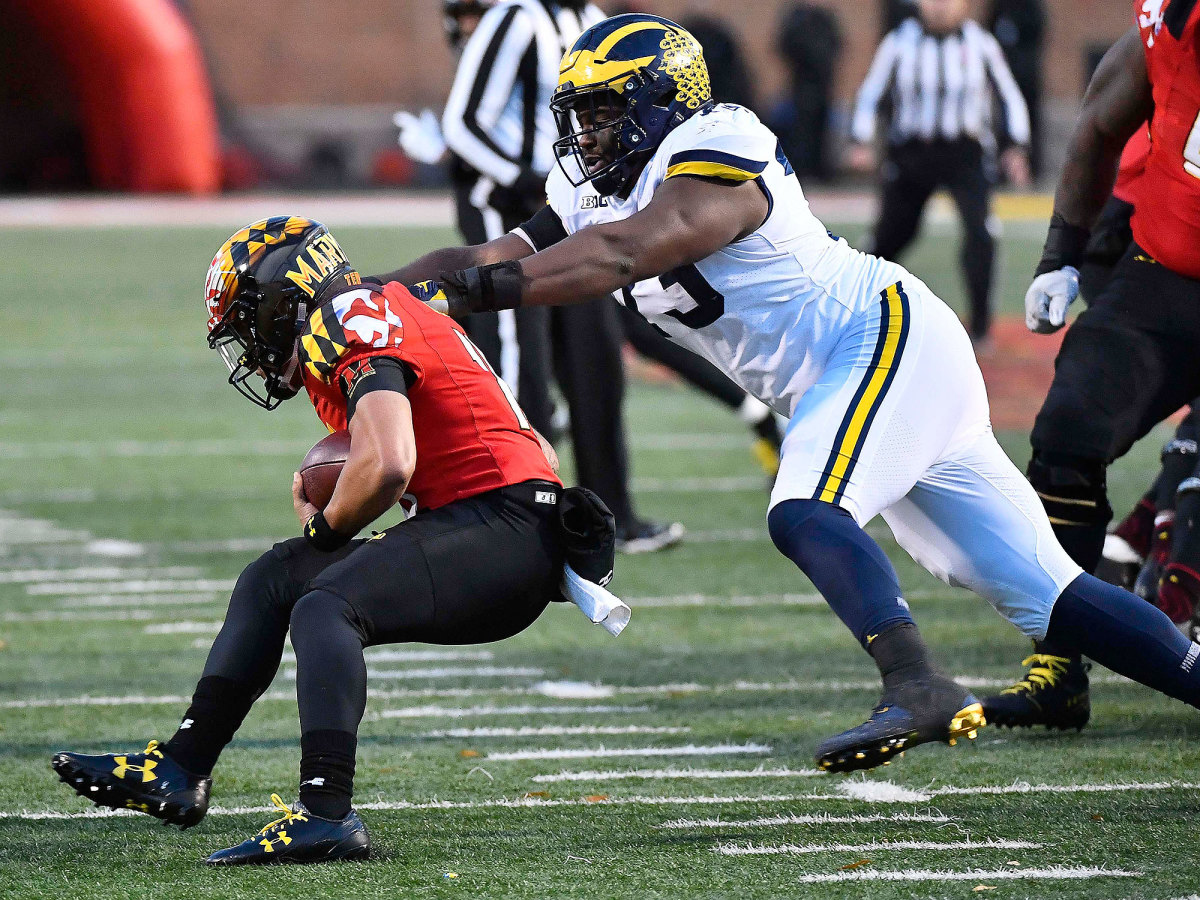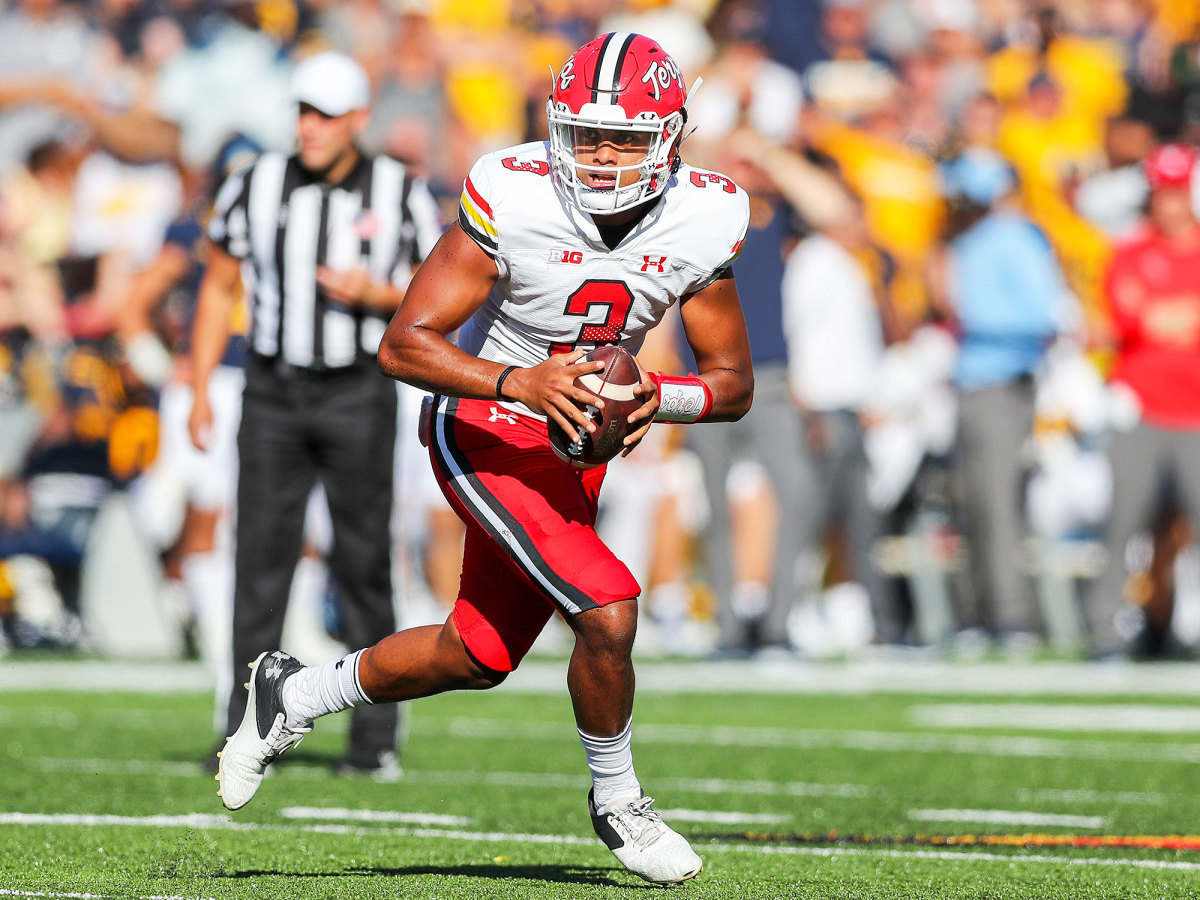After a Decade of Misery, Taulia Tagovailoa Is Resurrecting Maryland's QB Position

There is voodoo here, in College Park.
There must be, says C.J. Brown, the former Maryland quarterback.
How else do you explain what happened at the QB position at this place over the last decade?
Bad luck? No single person or program has this bad of luck.
A fluke? No no, it’s happened too many times to be deemed flukish.
Cursed? Maybe so. Maybe the quarterback gods just hate the Terrapins.
“Nobody can explain it,” says Johnny Holliday, in his 43rd year as Maryland football’s play-by-play voice.

Truth be told, Brown himself was there in 2010 for the start of it all, when this alleged voodoo, this awful curse, descended upon the program. The 10-year stretch of quarterbacking is unrivaled in college football. No program can attest to such inefficiency and instability at the game’s most important position.
In this, Maryland stood alone. It was a quarterbacking graveyard, an infirmary for passers. How the Terps won 38 games over that stretch seems like a miracle in itself.
In 10 years, 11 quarterbacks started at least one game and eight of them started at least seven games. Included in that is a walk-on and a linebacker-turned-quarterback.
More than half of those QBs averaged less than 150 passing yards per start and only one topped the 200-yard mark. Three of them threw more interceptions than touchdowns. In fact, in 2015, Maryland quarterbacks combined to throw a nation-high 29 interceptions, six more than the next highest FBS team and 16 more than the average.
During the stretch, one signal-caller tore his ACL in consecutive seasons, and three QBs tore ACLs in the same year. In all, at least a half-dozen of the QBs suffered some kind of season-ending injury.
Brown has the luxury of being the only quarterback to start every game of a season over that dismal decade.
“There's definitely bad luck in there,” Brown says. “One year, we ended up starting a true freshman linebacker. Maybe there’s some voodoo stuff going on.”
“You can’t make it up,” Holliday bemoans.
This place is scarred because of it, so emotionally damaged that longtime friends of the program are both excited about the emergence of their QB savior, Taulia Tagovailoa, while also afraid that the bad juju is coming for him like it came for the rest.
“Everybody is still cautiously optimistic that he’s real,” says Mike Locksley, the team’s third-year coach.
He is, in fact, real—all 5-foot-11, 200 pounds of him. And he is, in fact, good—already having amassed three 300-yard passing games this season. Before he arrived at Maryland in 2020, the program had gone 82 consecutive games without a 300-yard passer, a further indictment of its recent QB history.

Tagovailoa is on pace to set the school’s single-season passing mark by 600 yards. Only six quarterbacks nationally have thrown for more yards (1,340), only nine have tossed more touchdowns (10) and only two have a better completion rate (75.5%).
Locksley compares his quarterback to a guy named Johnny Manziel, a play-extending, deep-ball passing athlete with escapability who, the coach puts it, is “super accurate.”
So maybe the witch doctor is gone? The voodoo is out? The curse is over?
Maybe. At least for now, Tagovailoa has the Terps one victory from their first 5–0 start in 20 years. They’ve beaten West Virginia, won at Illinois and routed Howard and Kent State, setting up a Big Ten showdown on Friday against No. 5 Iowa (4–0).
It’s the toughest test yet for Maryland’s quarterback savior, the one with the famous brother and notoriously hard-charging father. Many know the story by now. The Tagovailoa brothers, Tua and Taulia, were groomed as quarterback robots in Hawaii before moving to Alabama, where the older son starred for the Crimson Tide and evolved into a first-round draft pick.
And what of the younger son? Lia, as they call him, signed with Nick Saban, too. But he transferred here after his freshman season in 2019 to “do his own thing,” he says.
Taulia never even visited campus. He didn’t have to. The man who recruited him to Alabama and coordinated his brother’s electric offenses was the head coach.
“Before I went into the portal, I had my mind set —I’m going to Maryland,” he says. The only other team he considered was Miami, which then employed another former Tide coordinator, Dan Enos, who now just so happens to be Maryland’s OC.
The gang's all back together.
And with it has come an electric unit. Maryland is eighth nationally in passing offense and 13th in total offense. Friday night in College Park will feature the unstoppable force against the immovable object. The Hawkeyes own the third-best scoring defense in the country, a quintessential Kirk Ferentz team that makes few mistakes on offense and swallows opposing quarterbacks.
In front of a nationally televised audience on FS1, Maryland’s quarterback resurgence is put to the ultimate test. It can’t be any worse than the last decade.
The Terps have struggled to find a consistent QB since coach Ralph Friedgen was fired in 2010. But these issues linger many more decades. The school hasn’t developed an NFL QB since Shaun Hill (2000–01) and hasn’t had a QB drafted since 1991, when Scott Zolak was selected in the fourth round.
And to think, at one point, the university dubbed itself as “Quarterback U,” says Locksley, a Washington D.C. native who rooted for the Terps as a child. “My era growing up we had great quarterbacks.”
Starting in 1984, a Maryland quarterback was selected in three straight drafts: Boomer Esiason (1984), Frank Reich (1985) and Stan Gelbaugh (1986). After their exits, the program had just two winnings seasons in the next 14 until Friedgen arrived in 2001.
Ten years later, the quarterback—and head coach—merry-go-round began. The Terps have had five different head coaches since. The QB failures started on the recruiting trail.
In 10 signing classes from 2009–2018, Maryland signed 13 quarterbacks. Six eventually transferred, four completed their careers in College Park, two moved positions and one retired from the sport. Of the 13, five never threw a single pass.

Among the group of 13, the stats are dismal. None of them finished their career with better than a 59% completion rate in games they started. Three of the seven who played significantly fell below the 50% mark. Two had more interceptions than touchdowns. And together, they averaged a paltry 168 yards passing per start.
If Maryland quarterbacks weren’t struggling, they were injured.
Consider this: In 2012, Maryland had to start Shawn Petty, a linebacker, after four different quarterbacks suffered season-ending injuries. In 2017, they lost three more quarterbacks to injury and started a walk-on, Ryan Brand, late in the season against Michigan.
“It’s one of those situations where you never think you could get into,” says Randy Edsall, the coach at Maryland from 2011 until his firing in 2015, of that ’12 season. “We tried to put together game plans that worked to Shawn’s advantage. Never been through that before.
“I don’t know if you want to call it bad luck or what,” he says.
Voodoo, maybe?
“Well,” says Edsall, “one of the issues was we had Dwayne Haskins committed and I got fired mid-year. We were going to have a quarterback. I got let go after the Ohio State game. Dwayne was committed to us and was all set to go. He ended up going to Ohio State.”
Some attribute the QB struggles to the coaching and coordinator turnover. Scott McBrien, the Terps quarterback in 2002–03, served as a color analyst for the school’s radio broadcast during that dismal decade of play under center.
Over the course of those years, the team had five different offensive coordinators and five completely different offensive systems, he says. There was James Franklin’s West Coast offense (2010), then Gary Crowton’s no-huddle hurry-up (2011), followed by Locksley’s multiple spread look (2012–15). Walt Bell brought in a five-receiver scheme that called for the QB to check with the sideline for calls (2016–17) and then Matt Canada’s system was derived from the jet sweep. Enos took over for Scottie Montgomery, who employed the scheme Locksley used at Alabama.
“You can’t have quarterbacks running multiple different offenses every other year,” McBrien says.
Asked about Maryland’s quarterback history, Taulia Tagovailoa gives a verbal shrug.
“Not too sure,” he says. “I’m just here to win football games.”

Taulia is like his brother in many ways, Locksley says. The mannerisms, his quick release, his competitive nature and his preparation. For instance, Taulia brings a notebook virtually everywhere he goes. He writes down everything Locksley tells him.
“You got to be careful what you say,” the coach says. “It’s going to come back to haunt you if you’re not consistent in what you tell him.”
He’s unlike his brother in many ways too. Growing up, Taulia was the chubby one, he says, but he could snap the ball. He started in football as his brother’s center.
Nowadays, he considers himself “Tua 2.0,” and he’s okay with that. Who’s the better passer? Who’s the fastest runner? Who’s the best overall quarterback? Taulia shrugs off those questions and turns to a much more serious contest.
“A lot of people tell me I’m the better looking one,” he chuckles.
Perhaps it’s good Taulia is unaware of the Maryland quarterback voodoo. In fact, yes, keep it from him forever. No one tell him a word. No utter. No hint.
All of that is in the past now. For Maryland, its eyes are forward on its savior at this cursed position.
“You finally got a guy and you say, ‘Here’s the guy we’ve been looking for,’” Holliday says. “We hold our breaths now.”
More College Coverage:
• Ranking All 10 FBS Conferences in 2021
• What a 12-Team Playoff Would Look Like After Week 4
• College Football Hot Seat Check
